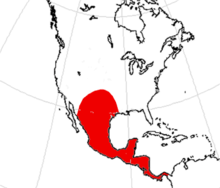Paratoceras
| Paratoceras Temporal range: Miocene | |
|---|---|
| Scientific classification | |
| Kingdom: | Animalia |
| Phylum: | Chordata |
| Class: | Mammalia |
| Order: | Artiodactyla |
| Family: | †Protoceratidae |
| Genus: | †Paratoceras Frick (1937) |
| Species | |
| |
 | |
| Range of Paratoceras based on fossil record | |
Paratoceras is a medium-sized extinct genus of Artiodactyla, of the family Protoceratidae, endemic to North America from the Miocene epoch, 16.3—15.97 Ma, existing for approximately 0.33 million years.[1]
Taxonomy
Paratoceras was named by Frick (1937). Its type is Paratoceras macadamsi. It was assigned to Protoceratidae by Frick (1937) and Carroll (1988); and to Protoceratinae by Webb (1981), Prothero (1998), Webb et al. (2003) and Prothero and Ludtke (2007).[2][3][4]
Morphology
Paratoceras resembled deer. However they were more closely related to camelids. In addition to having horns in the more usual place, protoceratids had additional, rostral horns above the orbital cavity. Paratoceras was larger than Eocene members of Tylopoda: Heteromeryx, Leptoreodon, Leptotragulus, Toromeryx, Trigenicus and Poabromylus.
Body mass
A single fossil specimen of Paratoceras was measured by M. Mendoza, C. M. Janis, and P. Palmqvist for body mass.[5] The specimen was determined to weigh:
- Specimen 1: 73.3 kg (160 lb)
Fossil distribution
Fossils have been recovered from:
- Gaillard Cut, Panama
- Balumtum Sandstone Formation, Chiapas, Mexico
- Suchilquitongo Formation, state of Oaxaca, Mexico
- Trinity River Pit 1, Fleming Formation, San Jacinto County, Texas
References
- ↑ PaleoBiology Database: Paratoceras, basic info
- ↑ S. D. Webb. 1981. Journal of Vertebrate Paleontology 1(3-4)
- ↑ R. L. Carroll. 1988. Vertebrate Paleontology and Evolution. W. H. Freeman and Company, New York 1-698
- ↑ D. R. Prothero and J. A. Ludtke. 2007. Family Protoceratidae. in D. R. Prothero and S. Foss (eds.), The Evolution of Artiodactyls 169-176
- ↑ M. Mendoza, C. M. Janis, and P. Palmqvist. 2006. Estimating the body mass of extinct ungulates: a study on the use of multiple regression. Journal of Zoology 270(1):90-101